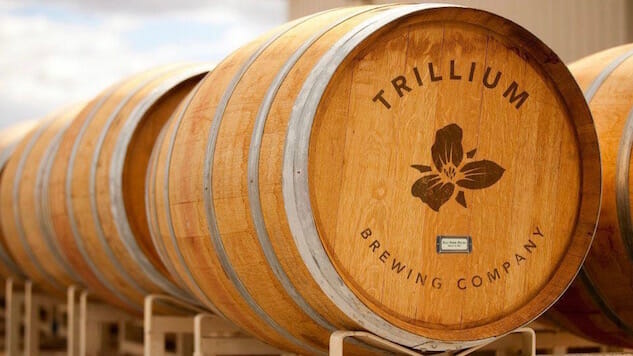9 Questions for Trillium Brewing’s Founders
Photo via Trillium Brewing
When you envision a farmhouse brewery, you probably wouldn’t picture that brewery in a city like Boston. But it’s been three years since JC and Esther Tetreault first opened Trillium Brewing, a brewery dedicated to farmhouse ales, in downtown Boston. While three years isn’t long enough for most to learn how to climb the stairs, Trillium has already made a name for themselves with beers like Fort Point Pale Ale and Pot and Kettle Porter—both of which have massively high ratings on both Beer Advocate and Rate Beer—and managed to outgrow their original Fort Point location; this past December, Trillium opened up their second location in Canton, Massachusetts. We caught up with JC and Esther to discuss how Trillium came to be and where they’re headed in 2016.
Paste: You were a homebrewer for over eight years prior to opening Trillium, what beers/breweries inspired you to get into brewing?
JC Tetreault: You don’t have to look much further than one of our mixed microbe cultures to answer that question. Our ‘Trillium Bug Blend’ culture was started with dregs from bottles of Jolly Pumpkin, Cantillon, Drie Fonteinen, Russian River, and a particularly good bottle of Fantome. Esther arranged a birthday surprise meeting with Dann Paquette (co-founder of Pretty Little Things Beer and Ale Project) to discuss my growing obsession about opening a brewery. I absolutely loved his take on a hoppy American saison in Pretty Things Jack D’or, which served as a reference point for the first beer we brewed, Trillium Farmhouse Ale, which takes a very simple grist (and firm bittering charge) but derived its complexity from the blend of four farmhouse yeast strains.
On the hoppy side of the equation, about six years ago, I had a pour of Hill Farmstead’s Double Galaxy at The Publick House’s annual fundraiser Hop Head Throwdown. That was the first time I tried a beer that featured that variety, which was unmistakably unique and incredibly intense but paradoxically delicate and balanced in comparison to the palate shredders that made up most of the double IPA offerings at the time. Around that time, we were brewing test batches of our flagship pale ale (now Fort Point Pale Ale) primarily designed around the Citra hop (initial designs included a good portion of Centennial too). Fort Point was intended to be our first stake in the ground—a very bold starting point—to where I envisioned our hop forward beer to ramp up from. I knew after trying that Hill Farmstead beer that Trillium’s IPA had to be focused on Galaxy. Despite best efforts, I couldn’t scrape together any Galaxy on spot purchases when we first opened, so instead of picking some other hop to feature in an IPA, we simply held off brewing our first IPA (Congress Street) until I could get a few boxes.
Paste: Have any of your homebrews become flagship beers at Trillium?
JC Tetreault: We brewed and packaged three of our favorite homebrews for our wedding in 2009. Stonington Pale Ale, named for the town we were married in, was the foundation for Fort Point Pale Ale, our current flagship pale ale. We also had Pot & Kettle oatmeal stout and we loved that beer so much, but we evolved it into the porter it is now.
Paste: Those homebrews were originally made on a wine making kit from Esther’s mom. How did she react when you converted that into a home brewing kit?
JC Tetreault: I think she gave me too much credit. I didn’t exactly have to pull off serious MacGyver moves to brew some beer with it! She definitely loves that she helped to point Esther and I down this path.
Paste: You recently released a new batch of Apricot Stonington, tell us about your barrel program.
JC Tetreault: We’re pretty pumped about getting to focus more on our wild beer program, leaning primarily toward beers fermented with our native New England microbe culture. We are incredibly passionate about these beers, but also quite patient! Beers like Apricot Stonington take just under two years from the time we brew the beer, ferment in stainless, rack to barrels, back into stainless to ferment/condition on fruit, then package and condition further. There are quite a few batches pretty far along and almost ready to release (i.e. Cuvee de Tetreault, Wild Sinister Kid) so we should start to see these beers release on a more frequent basis. We’ve otherwise already transitioned the Congress Street facility almost entirely for wild beer production, which will continue to have both barrel aged as well as stainless-only wild beers. Likewise, we designed the Canton facility to support the production of a significant quantity and variety of wild beer. We’ve got the space and functionality to handle five hundred barrels, 16 different 30-barrel foeders as well as some dedicated stainless for maintaining our native and other microbe culture, temperature controlled fermentation, blending and aging beers on fruit.
Paste: Do you have plans to barrel age stouts like PM Dawn and Night & Day, or will your program be strictly farmhouse ales for now?